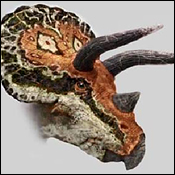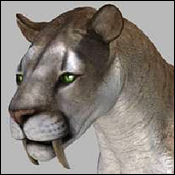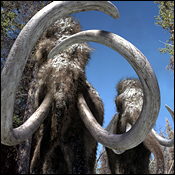 Triceratops horridus"Horrible three-horned face" (Marsh, 1889)"try-ser-rah-tops ho-rid-uss"
Triceratops horridus"Horrible three-horned face" (Marsh, 1889)"try-ser-rah-tops ho-rid-uss" Horrible herbivore Triceratops, the eight-ton sparring partner of T. rex, browsed the coastal lowlands of Montana 67 to 65 million years ago. Because of its horny beak, it was probably a more choosey feeder than the broad-snouted duckbill dinosaurs that shared its habitat.
The classic ceratopsian neck frill is formed from bones that grew from the back of the braincase. In Triceratops, this frill is made of a solid sheet of bone. Many of its relatives had longer frills, but these were mostly simple struts surrounding open hollows.
The famous three horns on its head were probably used for displays and strength contests with other Triceratops. It was formerly thought that the frill evolved for protecting the neck from tyrannosaur attacks and that the horns were used in defense. However, the hollow frills of other species would not be so useful for protection, and some types of ceratopsians have no facial horns at all! In fact, the horns probably were locked with other Triceratops in displays of strength. It was probably brightly colored to attract attention, especially in the breeding season. The horns and frill changed shape as it grew to an adult; this gave each animal a slightly different look.
Triceratops lived in the final two million years of the Cretaceous period. Triceratops became extinct 65 million years ago, the time when scientists believe a cataclysmic event led to mass extinctions. This sudden climate change is called the K/T Boundary, and it closed the Cretaceous period and opened the Tertiary period.

Smilodon populator"Devastating knife-tooth""smy-lo-don pop-yoo-lay-tor"
Smilodon populator was one of the biggest cats of all time. It was the largest of the saber-tooths, and lived in South America during the Late Pleistocene: about two million to 10,000 years ago. It originally evolved from ancestors that invaded the continent North America about three million years ago.
The saber-tooths were specialist predators that fed on large-bodied prey. It has been an enduring mystery as to how Smilodon used its huge teeth when hunting. Some scientists think that it would slash at prey, causing huge wounds. A more likely theory suggests that the sabers evolved for a neck death-bite. In this scenario, Smilodon would hold down its struggling prey with its huge arms while it gripped the animal's throat with its mouth, the sabers slashing through arteries and crushing the windpipe. Prey quickly would be killed in this fashion, making it less likely the Smilodon would be injured.
Smilodon was unusual for big cats in that it only had a short, stubby tail. Perhaps the tail was not used for balance or communication as much as it is in other members of the cat family.
The extinction of most large-bodied herbivores 10,000 years ago meant that Smilodon had lost all of its favorite prey. Unable to compete with small-prey specialists like the cougar, the saber-tooths became extinct about 10,000 years ago and left no descendents

Deinosuchus"Terrible crocodile" (Holland, 1904)"die-no-soo-kuss"
Not many bones have been found of Deinosuchus, but there are enough to know that it was one of the biggest crocodiles ever. Weighing in at nine tons, with a 36-foot body, it was one of the largest carnivores.
One of its favourite meals was dinosaurs. Deinosuchus would wait stealthily underwater until its prey came too close, then with a powerful burst of speed would thrust out of the water to snatch its victim. Deinosuchus' long jaws could grasp and hold a struggling dinosaur as it dragged it into the water, rolling over and over to drown its prey.
The deep tail of Deinosuchus propelled the animal through the water while swimming. Legs were just used for walking on the lake bottom or supporting the body on land. Whilst walking on land, bony armour on the crocodile's back helped make the body rigid using a system of tendons attached to the backbone. This skeleton system created a special "high-walk," where the legs were not as sprawling as today's lizards'. This rigid body let it move quite fast, allowing it to gallop in a straight line. Changing direction was much more difficult and the perfect chance to escape for potential prey!
This titanic croc lived in the coastal lowlands adjoining the shores of the huge seaway that divided North America into east and west in the Late Cretaceous. Deinosuchus became extinct when this seaway dried up, its habitat lost.

Tyrannosaurus rex"Tyrant lizard king" (Osborn, 1905)"tie-ran-oh-saw-russ rex"
The most famous dinosaur of all, Tyrannosaurus rex, was also one of the very last. At 45 feet long and six tons, it was the biggest predatory dinosaur of the Late Cretaceous period. Its massive head, lined with unusually broad teeth, was a devastating weapon. T. rex held prey in its mouth, its arms latching onto the victim's body in a death grip. Their short construction and inward facing palms acted like corn-on-the-cob forks, ideal for clinging onto prey and drawing them closer to the terrible mouth. Any struggling by the prey merely served to deepen its wounds and hasten its demise.
T. rex was not a particularly fast runner, but its long strides suggest it could still reach speeds of up to 25 miles per hour. A large part of its brain was dedicated to an acute sense of smell, so it could sniff out a stinking carcass from miles away.
Mixtures of adult and juvenile tyrannosaur skeletons have been found together, suggesting that they may sometimes lived in small groups. This would have been an advantage in hunting, mobbing individual prey or spreading panic and confusion by attacking herd animals, all the better to help pick off a victim.
Living in the final two million years of the Cretaceous period, T. rex became extinct along with the rest of the dinosaurs and many other prehistoric animals.
 Mammuthus primigenius"Woolly mammoth" (Blumenbach, 1799)"ma-mooth-uss prim-ee-gee-nee-uss"
Mammuthus primigenius"Woolly mammoth" (Blumenbach, 1799)"ma-mooth-uss prim-ee-gee-nee-uss" Mammuthus primigenius lived in Europe at the end of the last Ice Age, 250,000 to 10,000 years ago. About the same size as a modern Asian elephant, woolly mammoths fed on tough grasses and shrubs that grew on the vast plains of tundra-steppe.
Whole frozen mammoths have been found in Siberia. Their massive bones and ivory have been collected from the permafrost for thousands of years. In fact, the name mammoth derives from old Estonian "maa": earth, and "mutt": hole, referring to the myth that mammoths were underground burrowers which died when their tunnels collapsed.
This particular species commonly is referred to as the "woolly mammoth" due to its thick, multi-layered fur coat, which helped it adapt to its cold environment. It had 3 inches of fat beneath the skin for extra insulation, and its ears were very small to avoid heat loss. Woolly mammoths' chewing teeth had a tight weave of enamel ridges and dentine on the grinding surface, ideal for a diet of tough grasses and shrubs.
Woolly mammoths disappeared at the end of the last Ice Age, perhaps a victim of a warmer, wetter climate or maybe hunted to extinction by man. Mammoths were not directly ancestral to any modern mammal species, so this particular lineage is now extinct.
No hay comentarios:
Publicar un comentario